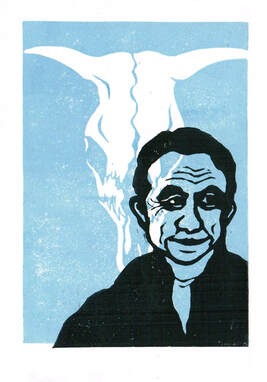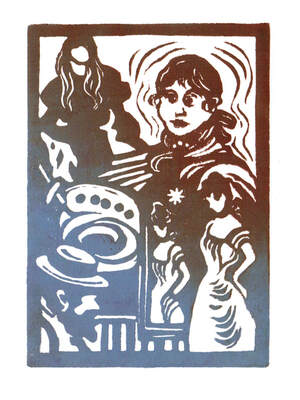|
My museum lecture at Dixon Gallery and Gardens is today, and I'll be talking about my art heroes and all the things I've learned along the way about making an art centered life. They're between exhibits, so they didn't need me to tie into any particular show, as I did when I talked about the history of plein air painting to go with their Barbizon exhibition some years ago. So I'm going to be self indulgent and talk about all my favorite artists and what I've learned from them in a slight gallop through art history.
I'm also going to talk about taking the time to do small projects for yourself, just because you want to. This was one of mine a couple of summers ago -- a series of tiny prints (I think they're 3x5") of my most formative artists. Constable, of COURSE, on the top left, for painting outdoors and non stop and in his own home places. Walter Anderson underneath him for pretty much all the same reasons plus printmaking. Georgia O'Keeffe for charting her own path and claiming the right to live where and how her muse dictated. And Berthe Morisot for just GOING for it, in an age where women didn't much. And also making her own career against the advice of older, established male artists who leaned heavily on her not to exhibit with those ragtag Impressionists. She was remarkable. The project fizzled there, and I hadn't even gotten a finished print of Constable until this week, but that also is good. Things you do because you want to but don't have to finish if you don't. The Anderson print made it into my show at WAMA, but the others were just because they sounded like fun.
0 Comments
I'm giving a talk at Dixon is this Wednesday (April 26) from 12-1 as part of their Munch and Learn program. You're welcome to bring a lunch to eat or just hang out. I know it's not built for working folks, but I'll be happy to see anyone who can make it. I'll be talking about formative artists for me and what I've learned along the way about making an art centered life.
I love a handout (from my student nerd-dom days), so I decided to put together a bibliography of my own creative life. These are the main creative books that have stuck with me over years, whispered to me, called me back to read them again. I won't get around to talking about them in the lecture by the time I've talked about all my favorite artists, so I put in a small synopsis of each one. I'll have them all with me on Wednesday for anyone to look at and see if they look right to order, but I thought it would be fun to go ahead and send out the list for all of you. (see below) It was a great thought experiment to come up with this list. It might be fun to make your own, or at least think in passing about what might go on it. Send along any books you think I'd love, and it would be cool to hear if any of you share some of mine. Add a comment here if you'd like to recommend or respond to my list. Creative Life Bibliography: Without Reservations Alice Steinbach – the middle-aged Eat Pray Love written ten years before Liz Gilbert's hit book, by and about a Pulitzer Prize winning columnist for the Baltimore Sun rediscovering herself through travel. It was hugely helpful in learning to listen to my own voice and curiosity after a hard early marriage. It also reminded me of the enormous benefits of travel. Alice is a great companion for a journey. Memoirs of John Constable C.R. Leslie – written by a friend of his and heavy on quotes from Constable's own letters. This is the Story of a Happy Marriage Ann Patchett – my number one inspirational book for ideas about the creative process and writing life, scattered in amongst other fantastic essays. The Getaway Car essay is most formative for me. House: A Memoir Michael Ruhlman – one writer buying and renovating an old home in Cleveland. A meditation on a rooted sense of place and the way the spaces around us shape our lives and creativity. I reread this pretty regularly. The Artist on the Road: Impressions of Greece Richard Sheppard – the journal in both text and watercolors of Richard's trip to Greece with his dad. His sketches made me want to figure out watercolors and the book was a big influence on the travel journals I keep for myself. Edvard Munch: The Master Prints from the Epstein Family Collection – the catalog from the Dixon Munch show in 1991 that was hugely influential on my work. One of the first art books I bought for myself. Direct Watercolor Marc Taro Holmes – a beautiful step by step guide to one approach to watercolor that has helped me greatly in learning the medium. Mending Life: A Handbook for Repairing Clothes and Hearts Nina and Sonya Montenegro – a hand drawn book about mending instead of throwing away. It helped me mend one small corner of a large, crazy, out-of-control world mid-pandemic and is both philosophically beautiful and practically helpful. The most recent book here, but a turning point for me. #AmWriting podcast – a wonderful, warm conversation between friends about writing – the inspiration, the practicalities, how to balance a small creative business with the rest of your life, and how to set goals and achieve the things you want to. Massively inspirational, and it has also helped me organize the details of my own small business so much better. Start with the earlier ones that appeal to you from the list. Linocut Friends – group on facebook full of printmakers who are supportive and helpful Urban Sketchers – FB group, IG hashtag, blog – sketchers around the world drawing and showing the world “one sketch at a time”. I also find my favorites and follow them individually. Hugely inspirational and great information on drawing materials to try. Please order books from Burke's, Novel, or other local stores. Buying art supplies from The Art Center, staffed by helpful artists, is also a key credo and source of life happiness for me. Henry and I went to the farm over the weekend to join my folks for a visit and pick the last of the spring bulbs. A friend calls these "twin sister" narcissi, which I just love. We have a beautiful ton of them, so I picked enough to scatter around in several vases, and last night I was watching a little British tv and decided to sketch them at the same time. I did the green background first, and then the light changed to really pick up a lovely purple on the window glass behind. I had some free standing paper I wanted to test for an upcoming project, so I did a second version. Both a just free painting with watercolor, no drawing first. I don't often work that way, but I was really interested in the shape of the flowers as a mass and just started drawing around them with the brush. It's good to get out of my comfort zone and play with new ways to work.
It's the last week for the lovely American paintings show at Dixon, and the director Kevin Sharp was giving a lecture yesterday as well, so I treated myself to another museum day. I'm getting out less than I used to with my separation anxiety dog (as well as a natural tendency to stay home a lot anyway), but I'm finding that when I do get good opportunities, I make them count more. Instead of saying, maybe I'll go to Dixon tomorrow or next week, if a friend wants to take Henry to the office for today, I jump right on that chance to do something really worthwhile. So Henry got to be an office dog yesterday, and I got a museum day. I had one more painting I really wanted to sketch, this William Trost Richards painting of Maine. Once again, it's a bit darker and more vivid (especially in the water) than the original since I was working in low light with limited media. But overall I'm pleased, and it will also just help me remember better. Then I had lunch outside (I'm still masking indoors) and started the tulip sketch but rushed back in to hear Kevin talk about the artist Walt Kuhn. I also worked a little bit on this Inness copy, toning it down some. It's not right, but I'm happier with it than I was. And I finished off the day sitting outside and finishing the tulip sketch at the top. I hadn't used my green ink lately, and the spring greens have had me itching to get it back out.
I keep going back to sketch in the Dixon show of American paintings. I think (hope) it has one more week for me to get back and sketch a little more. It's frustrating in some ways. You have to use dry media in the gallery (European museums are much more forward thinking about copying with paint), so I can't mix colors and gray things down a bit as I would like to. Dry colors (pencils, watercolor crayons, etc.) tend to be a bit more candy colored overall, so these colors are off a good bit, most especially on the lovely, subtle Inness. He's one of my favorites. But it's still deeply profitable as an artist to spend time looking at a painting deeply enough to sketch it even if the sketch is never what I hope it would be.
The colors were reasonably right for the Sloan, though (above). Sloan mostly painted cityscapes and was instrumental in the Ashcan school. I was drawn to this landscape, a summer holiday with his wife, precisely because he brought that fuller bodied intensity to a pastoral landscape. His colors are almost shocking side by side with the oranges and greens and a deeper blue green sea than I managed to convey here. It's an arresting piece, and I love the brushwork in it as well. |
online store Martha Kelly is an artist and illustrator who lives and works in Memphis, Tennessee. Get occasional studio email updates. Categories
All
Archives
June 2024
|











